10 Frequently Asked Questions about Spiral Binding
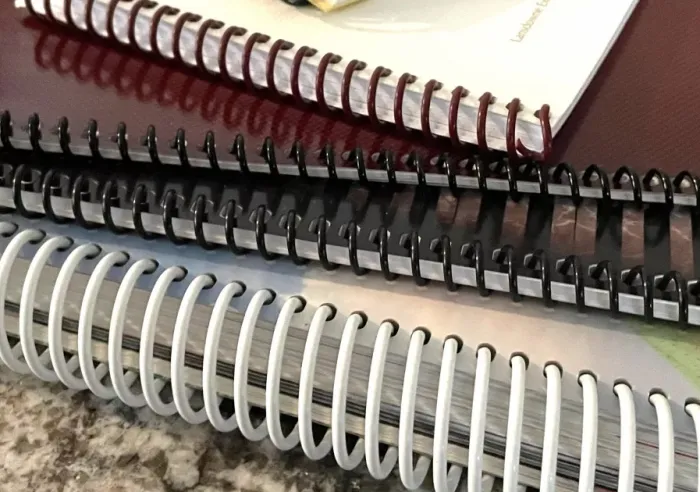
estimated reading time: 6 minutes
1. What is the biggest advantage of Spiral Bound Book Printing?
The primary advantage of Spiral Binding is that it is very
user-friendly. This binding method uses a spring-like coil that is threaded
through a series of holes punched along one edge of a book's pages and cover. Because
the pages and cover rotate so freely around the coil, spiral bound books can
open to a full 360 degrees.
This feature allows a book to lie completely flat on a desk
or table without needing to be continually held open. In other words, when a spiral
bound book is opened to the desired page, the page stays put. This leaves both hands free to perform other
tasks while referencing the content within the book.
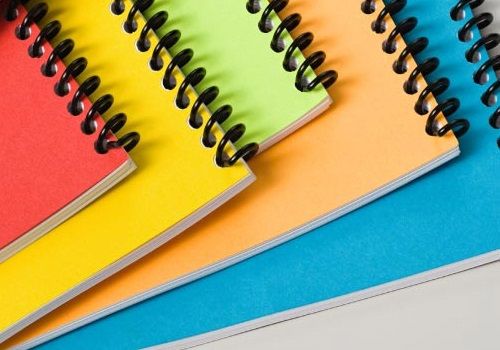
2. What types of projects are typically Spiral Bound?
Being able to lie perfectly flat on a desk or table, whether
open 180 or 360 degrees, makes the spiral binding method an ideal fit for presentations,
seminar materials, workbooks, study guides, journals, directories, coloring books
and activity books.
Also, the "hands-free" feature makes spiral
binding the perfect choice for content that needs to be referred to while doing
something else with one's hands. For example, spiral binding is a very popular binding
choice for cookbooks because it leaves the hands free to measure and combine
the ingredients of a recipe. Spiral binding is also perfect for books of sheet
music because the book will remain open to the desired page while a piano, guitar, or other musical instrument is being played.
Similarly, spiral binding is a good choice for assembly and
instruction guides, repair and maintenance manuals, travel guides, craft books,
and any other book that would benefit from the convenience of easy referencing.
Multi-page wall calendars are also frequently created with spiral binding
because the coil allows the pages to hang flat against the wall.
By the way, the spiral binding method also works really well
for any bound document that contains index tabs.
3. What are the minimum and maximum page counts for Spiral Bound Book Printing?
Spiral binding coils are available in a wide range of sizes, from a small diameter of 1/4" to a large diameter of 2".
As you would expect, a spiral coil can bind as few as two (2) sheets of paper. Since each sheet of paper has two sides and each side counts as one page, the minimum page count for spiral binding is 4.
Regarding the maximum page count for spiral binding, the
answer is a little more involved. As mentioned above, the largest binding coil
is 2" in diameter. This 2" coil can bind a paper stack that has an overall
thickness of 1.75". How many pages this equates to will depend on the thickness
(caliper) of each sheet.
For the sake of comparison, we'll use 20# bond and 80# gloss cover
as our paper examples…
One sheet of standard 20# bond copy paper is approximately .004"
thick. This means there would be about 438 sheets of 20# bond paper in a stack
measuring 1.75" in thickness. Since each sheet of paper counts as two pages,
this would mean a 2" binding coil could bind a maximum of 876 pages if the
paper was 20# bond.
If the paper happened to be 80# gloss cover, each sheet
would be approximately .0075" thick. This means there would be about 233 sheets
of 80# gloss cover in a stack measuring 1.75" in thickness. Again, since each
sheet of paper counts as two pages, this means a 2" binding coil could bind a
maximum of 466 pages if the paper was 80# gloss cover.
As you can see, without knowing the thickness of the paper
being bound there is no single answer to the question about maximum page count.
The answer will vary depending on which type of paper is being bound.
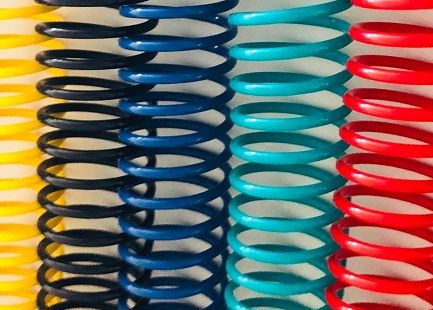
4. What material is used to make Spiral Binding coils?
Though metal wire is commonly used to make the coils of mass-produced
spiral bound books, most of the binding
coils used for custom-printed book projects are made of flexible PVC plastic. PVC
(polyvinyl chloride) is the most widely used plastic for binding coils because
it is strong, abrasion-resistant, and very affordable.
5. What are the color choices for Spiral Binding?
Compared to other "punch-and-bind" bookbinding methods, spiral
binding offers the widest selection of spine colors. In fact, there are over 40
color choices, including black, white, blue, clear, green, red, yellow,
burgundy, brown, gold, and silver. With so many choices, there is a complementary color available for virtually every book project. As far as popularity, black, white, blue, and
clear are the most requested color options.
6. What does "pitch" mean in reference to Spiral Binding?
The coils used for spiral binding are threaded through a
series of round or oval holes punched along one edge of a book's cover and
pages. References such as 3:1, 4:1, 5:1, etc. are ratios used to designate the
number of holes per inch. These ratios are known as the "pitch."
A ratio of 4:1 is the most widely used pitch for spiral
binding. It is verbalized as "four to one" and signifies a ratio of four
holes per one inch.
7. Can Spiral Bound books be sent through the mail?
Because the plastic binding coils are flexible and
resilient, spiral bound books are suitable for mail delivery. Unlike wire
binding, a plastic coil will not become permanently distorted if subjected to
pressure or rough handling during mail processing.
8. Is Spiral Binding suitable for crossover images?
A crossover image is one that spans across two opposing
pages of an open book. Because the image
displays on both sides of a page spread, it has to "cross over" the center
spine area. Though spiral bound books can be made with crossover images, it should
be pointed out that the image will not flow smoothly. It will be disrupted by
the holes punched for the binding coil, the coil itself, and the physical gap
that will exist between the left page and the right page. Also, unlike wire-o
binding or comb binding, the spine of a spiral bound book is helical. This
causes opposing pages to shift slightly up or down from each other, so the two
sections of a crossover image are unable to appear in perfect alignment. They will always be slightly offset.
9. Does Spiral Binding allow for pages to be easily removed or added?
The spine of a spiral bound book can be untwisted and
reinstalled to allow for the removal of pages or for pre-punched pages to be
added. Some printing companies even tout this feature. However, be forewarned
there are certain situations where it isn't as easy as it sounds. For example,
manually changing out the pages on a book or two isn't that difficult. But having
to do it on hundreds or thousands of books would be a nightmare. Also, winding
a coil back through a thin stack of pages is relatively simple. But winding a
coil back through a thick stack of pages can be surprisingly frustrating.
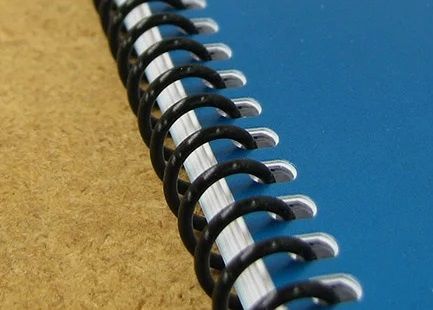
10. Does Spiral Binding go by any other names?
Spiral Binding is commonly referred to as Coil Binding or
Spiral Coil Binding. It is also sometimes referred to by a variety of generic
and brand names, such as Plastic Coil, Plastikoil, EZ-Coil, Color Coil and
Coilbind.
Need help with a Custom-Printed Book Project?
Color Vision has been producing custom-printed books
for four decades. If you have an upcoming book project and would like to
learn more about spiral bound book printing, or any other softcover binding style,
just give us a call at 800-543-6299 and we'll be glad to assist.
Or, if you would like to submit your project's
specs and receive an emailed quote, simply complete our Quote Request form. As
always, we look forward to assisting with your printing and binding needs!
Related Articles
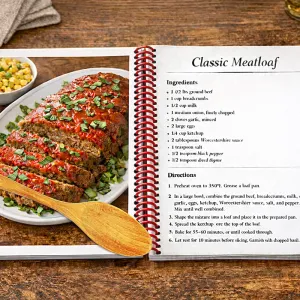
Which Book Projects Benefit From Being Spiral Bound?
Read This Article
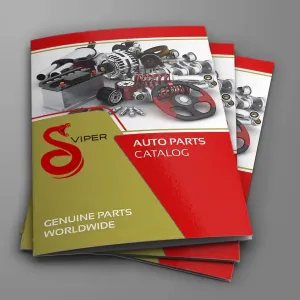
Booklet Catalogs: Why is this Catalog Format so Popular?
Read This Article
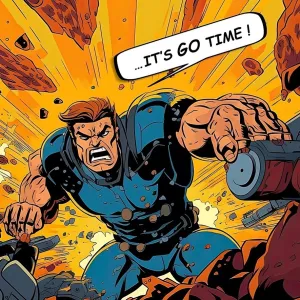
Creating a Comic Book? Here’s some Advice from a Printer
Read This Article

Perfect Binding vs PUR Binding: What is the Difference?
Read This Article